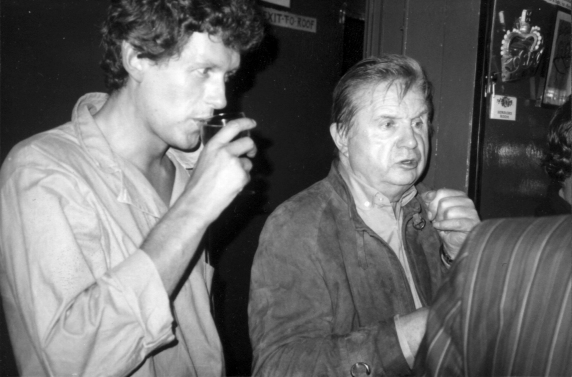|
|
|
Extract from a conversation between Michael Clark and Steve Wheatley, June, 1988 © Blessé
Whenever I visited London, I always looked out for the Colony Room Club, but could never find it. It was only after I’d moved to London and was walking through Soho to do some research at the British Museum, it was early one Tuesday evening in November, 1977, that I just came upon it in Dean Street. And there it was, as if in neon lights, ‘Colony Room Club, First Floor. Members only.’ So I just walked up the stairs, because I knew from an article in ‘Men Only’ that Muriel was supposed to accept anyone she liked.
So, I pushed the door open and went in. The first person I saw was Francis Bacon and the second person was an elderly lady on my left, who turned and said to me "Oh, Hello Dearie, how are you?” She greeted me as though I was a long lost friend. She was incredibly warm towards me and we had a marvellous conversation.
Then Francis came over and said “can I get you a drink young man?” The person behind the bar, Ben, moved along the bar to where a man, it was Ian Board, was sat on a stool. Ian walked towards me and said “Tell me, young man, are you a member?” and Muriel, though I didn’t know it was her at the time, grabbed my sleeve and whispered “Say yes, Dearie, say yes.” So, like an idiot, I said “No, but I would very much like to be.” And Ian said “You have to have someone to propose you.” So I said “Well, perhaps this lady might.” And Ian said “I’m sorry, you have to have two people to propose you. “ I said “Well, perhaps Mr Bacon might second me.” Anyway Ian then replied “I’m sorry, young man. You can’t just come in like that. Tell me you know the door where you came in?” “Yes.” “Will you kindly leave by it!”
As I walked out onto Dean Street, I was struck by two things. A picture came into my mind of Francis’s 1966 triptych of Muriel Belcher with the green background and I suddenly realised that it was Muriel I had been speaking to. I thought, how dare I be thrown out by someone behind the bar when Muriel wanted me to stay. And the other thing was how would I remember where the club was, as it wasn’t numbered.
Then I noticed this curious box outside, which had several left shoes in it. It reminded me of those early Giotto paintings with kind of ‘spaceframe’ buildings in them. Also Giacometti’s ‘spaceframes’ and of course the ‘spaceframes’ Francis uses in his paintings. So I thought, “I’ll remember this.”
Extract from a conversation between Michael Clark and Steve Wheatley, June, 1988 © Blessé |
 Clark & Bacon. Colony Room Club. circa 1980. Collection: the artist. © Michael Clark
Art On View by Richard Cork
The Standard Thursday November 25 1982
Muriel's men
Although I only visited the Colony Room Club once white Muriel Belcher was alive, it remains vividly in my memory. Situated at the top of a shabby staircase in the middle of Soho this down-at-heel but welcoming space has been a favourite haunt British artists ever since she started it in 1948.
Francis Bacon, Lucien Freud, Frank Auerbach and Michael Andrews are perhaps the most distinguished of the painters who have frequented it. Their work dominates an affectionate tribute to Muriel Belcher at Michael Parkin Fine Art but the show emphasises that an extraordinary range of other artists also enjoyed hard-drinking visits to its premises.
Robert Colquhoun and John Minton were among its regular clientele in the 1950s, and nowadays it attracts younger artists like Michael Clark whose sensitive studies of both Bacon and Belcher are outstanding in the show.
Artists always retained a special place in Muriel Belcher's affections and after getting to know her they realised that beneath the formidable exterior was a kind and perceptive woman who deserved their love.
ARTISTS of the Colony Room Club at Michael Parkin Fine Art, 11 Motcomb St. SW1, until December 4th.
© 1982 The Standard. Richard Cork
Brian Sewell - Miss B's secret shrine to an unrequited love
Evening Standard Friday 27 January 2006
The studied drawings made by Michael Clark in the early 1980s tell a truer truth in feature, but the same troubling melancholy lies at their core....
It is primarily for these that the Bacon aficionado should see Miss Beston's sale for they may show him something of Francis that he did not suspect - Francis a man of Pathos and abject misery.
© 2006 Evening Standard. Brian Sewell |